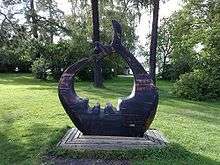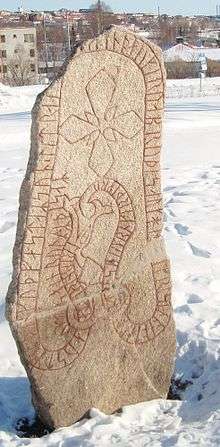Storsjöodjuret
 "The Great-Lake Monster" | |
| Sub grouping | Lake monster |
|---|---|
| Other name(s) |
Hydogiganta Monstruidae Jemtlandicum, Storsie (English) |
| Country | Sweden |
| Region | Storsjön, Jämtland |
| Habitat | Water |
In Swedish folklore, the Storsjöodjuret (Swedish pronunciation: [²stuːrɧøːʊˌjʉːrɛ], literally "The Great-Lake Monster") is a lake monster said to live in the 90-metre-deep (300 ft) lake Storsjön in Jämtland in the middle of Sweden. The lake monster is first attested in 1635. When the only city located by Storsjön, Östersund, celebrated its 200-year anniversary in 1986 Storsjöodjuret along with its offspring and nest became protected by law, a law which was revoked in 2005.[1]
Description
Storsjöodjuret is described as a serpentine or aquatic reptile with fins across its back and the head of a dog. It is reported to measure approximately six meters long, and some accounts describe it as having several humps.
History
Legends

The first description of a sea creature in Storsjön was made in a folklorist tale by vicar Morgens Pedersen in 1635.
"A long, long time ago two trolls, Jata and Kata, stood on the shores of the Great-Lake brewing a concoction in their cauldrons. They brewed and mixed and added to the liquid for days and weeks and years. They knew not what would result from their brew but they wondered about it a great deal. One evening there was heard a strange sound from one of their cauldrons. There was a wailing, a groaning and a crying, then suddenly came a loud bang. A strange animal with a black serpentine body and a cat-like head jumped out of the cauldron and disappeared into the lake. The monster enjoyed living in the lake, grew unbelievably larger and awakened terror among the people whenever it appeared. Finally, it extended all the way round the island of Frösön, and could even bite its own tail. Ketil Runske bound the mighty monster with a strong spell which was carved on a stone and raised on the island of Frösön. The serpent was pictured on the stone. Thus was the spell to be tied till the day someone came who could read and understand the inscription on the stone."[2]
Another legend was written down by the prolocutor Andreas Plantin in an inquiry in 1685.
"It is said that beneath this [rune]stone lies a dreadfully large head of a serpent and that the body stretches over Storsjön to Knytta by and Hille Sand where the tail is buried. The serpent was called a rå and therefore shall this stone be risen. Since no one peacefully could cross [Storsjön], the ferryman and his wife states, along with many others, that in the last turbulent time this stone was tore down and broken in two. As long as this stone laid on the ground many strange things occurred in the water, until the stone was risen and assembled anew."[3]
The runestone both texts refer to is the Frösö Runestone, the northern-most raised runestone in the World. However while a large serpent is indeed pictured on the stone there is no reference about it nor "Ketil Runske" in the text itself, which instead tells about Austmaðr, Guðfastr's son's christening of Jämtland. Though it has indeed been broken in two pieces.
Capture
Common interest in the creature was sparked first in the 1890s. After several sightings, an enterprise of locals was founded to catch the monster, even drawing the support from king Oscar II. Since then hundreds of monster sightings have been made. No scientific results have been made, but the supporters have never lost their faith.
In August 2008 a film crew claimed to have captured Storsjöodjuret on film, reporting that infrared cameras showed an endothermic mass in the lake.[4][5]
Protected status
In 1986, the Jämtland county administrative board declared Storsjöodjuret to be an endangered species and granted it protected status. However, it was removed from the list in November 2005.
References
- Rentzhog, Sten (editor); Jan-Öjvind Swahn; Stefan Brink; et al. (1989). Jämten 1990. Östersund: Jamtli/Jämtlands läns museum.
Notes
- ↑ "Fridlysningen". Storsjoodjuret.com. Archived from the original on July 26, 2009. Retrieved 2009-09-10.
- ↑ "Jata and Kata". Storsjoodjuret.com. Archived from the original on 2008-08-31. Retrieved 2008-06-29.
- ↑ Sundberg, Jan-Ove (1995). Storsjöodjuret, Seljordsormen, Nessie och andra sjömonster (in Swedish). Södertälje: Larsons Förlag, 17.
- ↑ "Sweden's Loch Ness monster possibly caught on camera". Yahoo. 29 August 2008. Archived from the original on 11 September 2008.
- ↑ SvD: Storsjöodjuret fångat på film
External links
- Official page of Storsjöodjuret In Swedish, English, German
- Great Lake Monster Website
